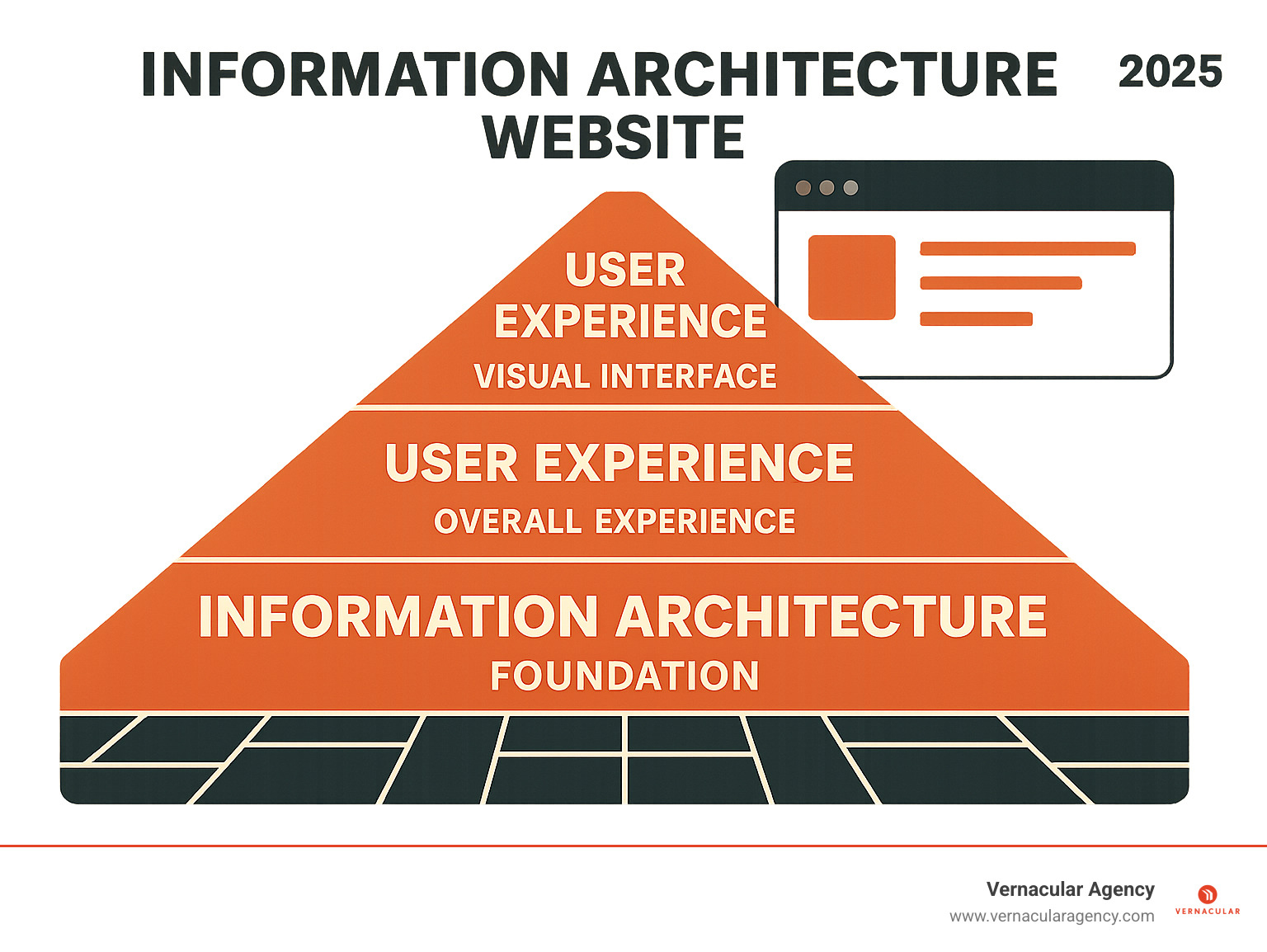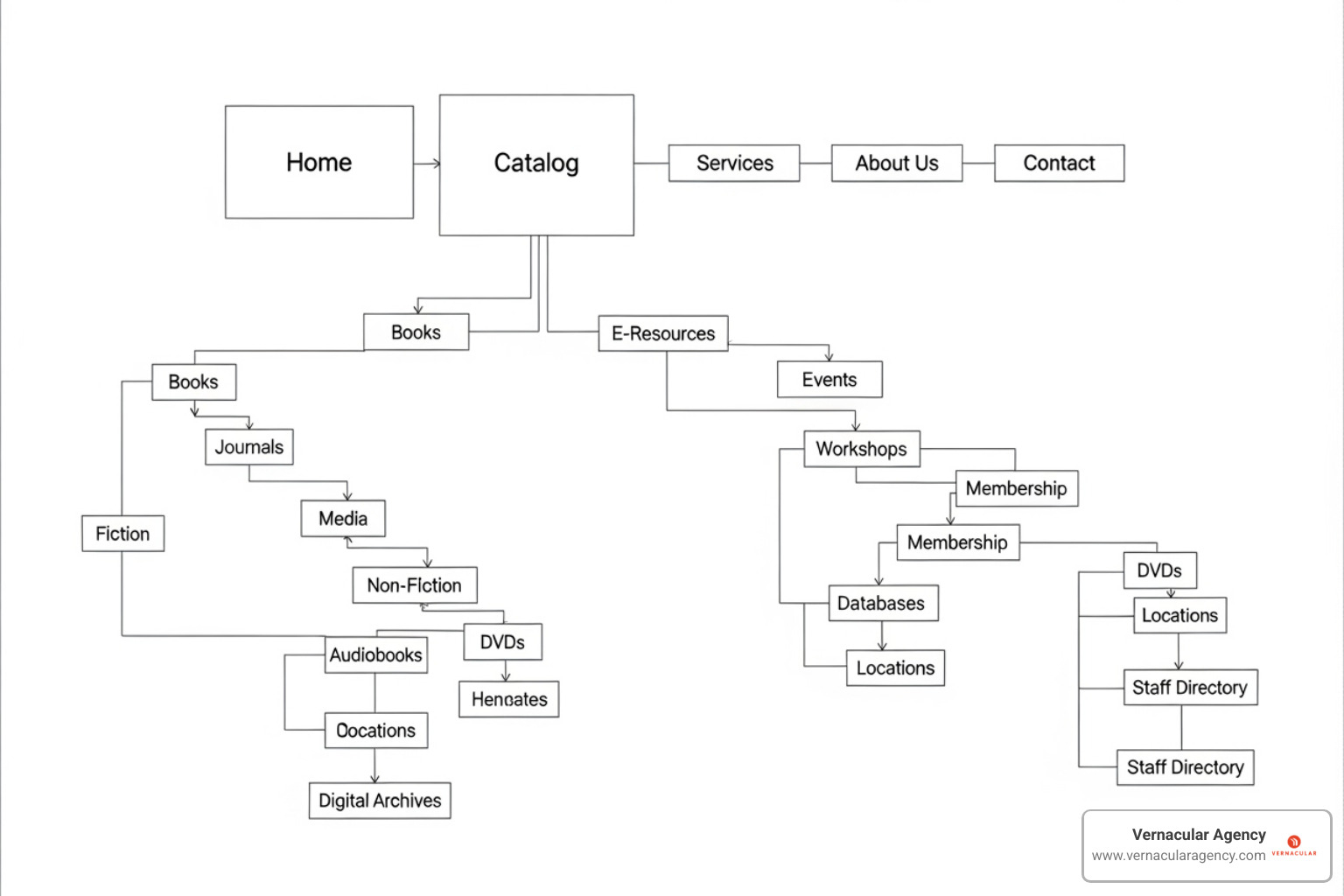An effective information architecture (IA) is the blueprint for a successful website, determining whether visitors find what they need or leave in frustration. It’s the practice of organizing and structuring content to be intuitive and easily accessible.
Key Elements of Website Information Architecture:
Imagine a library with no catalog—that's a website without proper IA. When users can't find what they're looking for, they abandon the site, often within seconds. Poor information organization costs businesses significantly in lost productivity and sales.
A well-structured website improves user satisfaction, boosts conversion rates, and reduces support costs. At Vernacular Agency, we've seen how proper information architecture website planning transforms confusing digital experiences into clear, purposeful journeys. It's the foundation of any successful digital presence.

Information architecture website word guide:
At Vernacular Agency, we see information architecture as the invisible backbone of any successful digital product. Its the art and science of organizing content so users can effortlessly find what they need. Think of it as the blueprint for a houseit defines the layout and ensures everything is functional and livable.
A common point of confusion is the difference between IA and a sitemap. While related, they are not the same. A sitemap is a visual map of your website's pages, but it's just one output of the broader IA process. Information architecture is the comprehensive, strategic process of defining how content is structured, organized, and labeled. IA is the abstract thought process, while a sitemap is a concrete artifact.
| Aspect | Information Architecture (IA) | Sitemap |
|---|---|---|
| What it is | Strategy and logic for organizing, labeling, and relating content | A document or page listing site pages and hierarchy |
| Purpose | Make content findable, usable, and scalable | Communicate page structure to users and crawlers |
| Typical outputs | Content models, taxonomies, navigation schemes, labeling rules | HTML sitemap, XML sitemap, page tree diagram |
| When created | Early and iterated throughout the project | After IA is defined; updated as the site evolves |
| Who uses it | Strategists, designers, product teams, stakeholders | Users (HTML), search engines (XML), dev/SEO teams |
Effective information architecture is built upon four fundamental building blocks:

Investing in a strong information architecture website isn't just about making users happy; it's a strategic business decision that yields tangible returns.
Creating a successful information architecture website isn't random; it's a science. Dan Brown's eight principles of IA provide a foundational guide for building intuitive digital experiences that grow with your business.
These principles focus on how to organize your information effectively.
These principles focus on how users move through your site.
These principles work together to create digital experiences that feel intuitive and grow gracefully. For examples of how these principles translate into real-world design, check out these great architecture websites.
Building an effective information architecture website is a methodical process that puts your users at the center of every decision. The process follows a natural progression: research, content strategy, prototyping, and testing.
This foundational step involves gathering intelligence about your users, content, and competition.
Instead of guessing how users think, we ask them. This collaborative approach produces better results.

Now we translate research into a tangible blueprint.
This systematic approach removes guesswork and ensures the final product is intuitive and effective, whether it's an architecture portfolio site or any other type of website.
Learning from successful information architecture website implementations helps us understand what works in the real world. At Vernacular Agency, we study how different industries tackle their unique IA challenges to inform our own design decisions.
These examples show how IA adapts to different user needs. For more inspiration, explore our showcase of great architecture websites.

Creating effective IA requires the right tools for each phase of the process.
Choosing the right tools depends on your project's complexity, but they are all designed to help you build a user-centric and effective website structure.
A well-planned information architecture website is not just for users; it's a cornerstone of effective Search Engine Optimization (SEO). A logical site structure helps search engines like Google understand and rank your content more effectively.
Good IA makes your site easier for search engine crawlers to steer and index. This is achieved through:
yourdomain.com/services/web-design) help both users and search engines understand the page's content.Search engines reward websites that provide a positive user experience. Good IA directly contributes to key engagement metrics that can boost your rankings:
These positive user signals tell search engines that your site is valuable and relevant, which can significantly improve its visibility in search results. For specialized industries, working with an SEO agency for architects can further leverage these principles for maximum impact.
Here are answers to some common questions about creating an effective information architecture website.
Think of information architecture as the blueprint of your house—it's the underlying structure and organization of all your content. Navigation, on the other hand, is the set of tools (like menus and links) that users interact with to move through that structure. Good IA is the foundation for good navigation.
Your information architecture website isn't a one-and-done project. We recommend a review whenever you're planning a major redesign or adding significant new content. For larger sites, a yearly IA audit is a good practice to ensure the structure still aligns with user needs and business goals. Pay attention to user behavior analytics, as high bounce rates or low engagement on key pages can signal a problem with your IA.
Absolutely not. Even a simple five-page website benefits from thoughtful IA. A solid structure from the start makes it much easier to scale your site later without needing a complete overhaul. Clear, logical organization isn't a luxury—it's essential for any business that wants to succeed online.
Your website is more than just a digital business card—it's the foundation of your entire online presence. A strong information architecture website provides the essential structure that transforms a scattered collection of pages into a powerful, user-friendly experience.
Just as you wouldn't build a house without blueprints, you shouldn't build a website without proper IA. It makes your content findable, guides visitors toward their goals, and improves user satisfaction, which in turn boosts conversions and SEO rankings.
Good IA is an ongoing commitment to understanding your users and organizing your content around their needs. It requires testing, refining, and adapting as your business grows.
At Vernacular Agency, we've seen how the right information architecture website strategy transforms businesses. We create comprehensive digital experiences that work seamlessly with your brand identity and marketing goals.
Ready to give your website the structure it deserves? Let's start building your high-performance website together. Because when your foundation is strong, everything else falls into place.